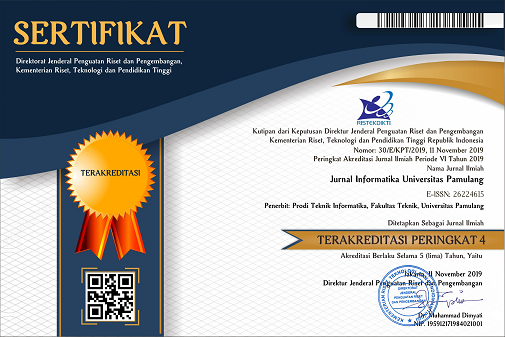Pengenalan Wajah Menggunakan PCA dengan Memperhatikan Jumlah Data Latih dan Vektor Eigen
DOI:
https://doi.org/10.32493/informatika.v6i1.7261Keywords:
Principle Component Analysis (PCA), feature, Manifold Learning, eigenface, eigenvectorAbstract
To find out if an employee is present, attendance is usually used. Attendance can be done in several ways, one of which is by filling in the attendance list that has been provided (manual attendance). However, this method is less effective because there is a possibility that employees who are not present will entrust attendance to employees who are present. Therefore, other ways are needed so that this does not happen. In this study, attendance was carried out using facial recognition. Face recognition is one of the fields used to recognize someone. A person's face usually has special characteristics that are easily recognized by people. These special characteristics are also called features. In this study, these features can be searched using the Principle Component Analysis (PCA) method. The PCA method is one of the methods used to produce features by reducing dimensions using eigenvectors from facial images (eigenface). The facial image used in this study consisted of 40 people with each person having 10 facial images with various expressions. Image data is divided into two parts, namely training data and test data. In this study, it is proposed to pay attention to the amount of training data and the number of eigenvectors used to get the best level of accuracy. From the research results, the highest level of accuracy occurs when the training data for each person is 7 and the test data for each person is 3 with an accuracy rate of 96.67%.
References
Ardiansiah, Setiawan, W., & Linawati. (2016). Sistem Pengenalan Wajah Dengan Metode Face Features. E-Journal SPEKTRUM, 3(2), 21–25.
Budi, A., Suma’inna, & Maulana, H. (2016). Pengenalan Citra Wajah Sebagai Identifier Menggunakan Metode Principal Component Analysis (PCA). Jurnal Teknik Informatika, 9(2), 166–175. https://doi.org/10.15408/jti.v9i2.5608
Fahrurozi, A., & Kosasih, R. (2017). Face Recognition Using Local Binary Pattern Combined With PCA For Images Under Various Expression and Illumination. Proceeding on International Workshop on Academic Collaboration 2017, May, 1–7.
Fandiansyah, Sari, J. Y., & Ningrum, I. P. (2017). Pengenalan Wajah Menggunakan Metode Linear Discriminant Analysis dan k Nearest Neighbor. Jurnal ULTIMATICS, 9(1), 1–9. https://doi.org/10.31937/ti.v9i1.557
Kardile, H. A. (2017). Face Recognition Using Pca and Eigen Face Approach. International Research Journal of Engineering and Technology (IRJET), 4(12), 460–463.
Kosasih, R. (2020). Kombinasi Metode Isomap dan KNN Ppada Image Processing untuk Pengenalan Wajah. CESS (Journal of Computer Engineering System and Science), 5(2), 166–170.
Kosasih, R., & Fahrurozi, A. (2017). Clustering of Face Images by Using Isomap method. Proceeding on International Workshop on Academic Collaboration 2017, May, 52–56.
Kosasih, R., Madenda, S., Karyati, C. M., & Etp, L. (2015). Determination the Optimal Position from T1 and T2 Weighted MR Imaging of the Abdominal Aortic Aneurysm. Advanced Science, Engineering and Medicine, 7(10), 915–919. https://doi.org/10.1166/asem.2015.1778
Muliawan, M. R., Irawan, B., & Brianorman, Y. (2015). Implementasi Pengenalan Wajah Dengan Metode Eigenface Pada Sistem Absensi. Jurnal Coding, 03(1), 41–50.
Mulyadi, R., & Zaini. (2020). Identifikasi Pengenalan Wajah Perokok Menggunakan Metode Principal Component Analysis. Jurnal Resti, 4(5), 892–898.
Nasution, M. Z. (2020). Face Recognition based Feature Extraction using Principal Component Analysis ( PCA ). Journal of Informatics and Telecommunication Engineering, 3(2), 182–191.
Putra, I. N. T. A., & Harjoko, A. (2018). Pengenalan Wajah Berbasis Mobile Menggunakan Fisherface dan Distance Classifier. JST (Jurnal Sains Dan Teknologi), 7(1), 135–145. https://doi.org/10.23887/jst-undiksha.v7i1.13267
Rosyani, P. (2017). Pengenalan Wajah Menggunakan Metode Principal Component Analysis (PCA) dan Canberra Distance. Jurnal Informatika Universitas Pamulang, 2(2), 118. https://doi.org/10.32493/informatika.v2i2.1515
Salamun, & Wazir, F. (2016). Rancang Bangun Sistem Pengenalan Wajah Dengan Metode Principal Component Analysis. Jurnal Teknologi Dan Sistem Informasi UNIVRAB, 1(2), 59–75. https://doi.org/10.36341/rabit.v1i2.25
Zein, A. (2018). Pendeteksian Multi Wajah dan Recognnition Secara Real Time Menggunakan Metoda Principle Component Analysis (PCA) dan Eigenface. Jurnal Teknologi Informasi ESIT, 12(01), 1–7.
Downloads
Published
Issue
Section
License
Authors who publish with this journal agree to the following terms:
- Authors retain copyright and grant the journal right of first publication with the work simultaneously licensed under a Creative Commons Attribution-NonCommercial 4.0 International (CC BY-NC 4.0) that allows others to share the work with an acknowledgement of the work's authorship and initial publication in this journal.
- Authors are able to enter into separate, additional contractual arrangements for the non-exclusive distribution of the journal's published version of the work (e.g., post it to an institutional repository or publish it in a book), with an acknowledgement of its initial publication in this journal.
- Authors are permitted and encouraged to post their work online (e.g., in institutional repositories or on their website) prior to and during the submission process, as it can lead to productive exchanges, as well as earlier and greater citation of published work (See The Effect of Open Access).
Jurnal Informatika Universitas Pamulang have CC-BY-NC or an equivalent license as the optimal license for the publication, distribution, use, and reuse of scholarly work.
In developing strategy and setting priorities, Jurnal Informatika Universitas Pamulang recognize that free access is better than priced access, libre access is better than free access, and libre under CC-BY-NC or the equivalent is better than libre under more restrictive open licenses. We should achieve what we can when we can. We should not delay achieving free in order to achieve libre, and we should not stop with free when we can achieve libre.
Jurnal Informatika Universitas Pamulang is licensed under a Creative Commons Attribution-NonCommercial 4.0 International (CC BY-NC 4.0)
YOU ARE FREE TO:
- Share : copy and redistribute the material in any medium or format
- Adapt : remix, transform, and build upon the material for any purpose, even commercially.
- The licensor cannot revoke these freedoms as long as you follow the license terms





